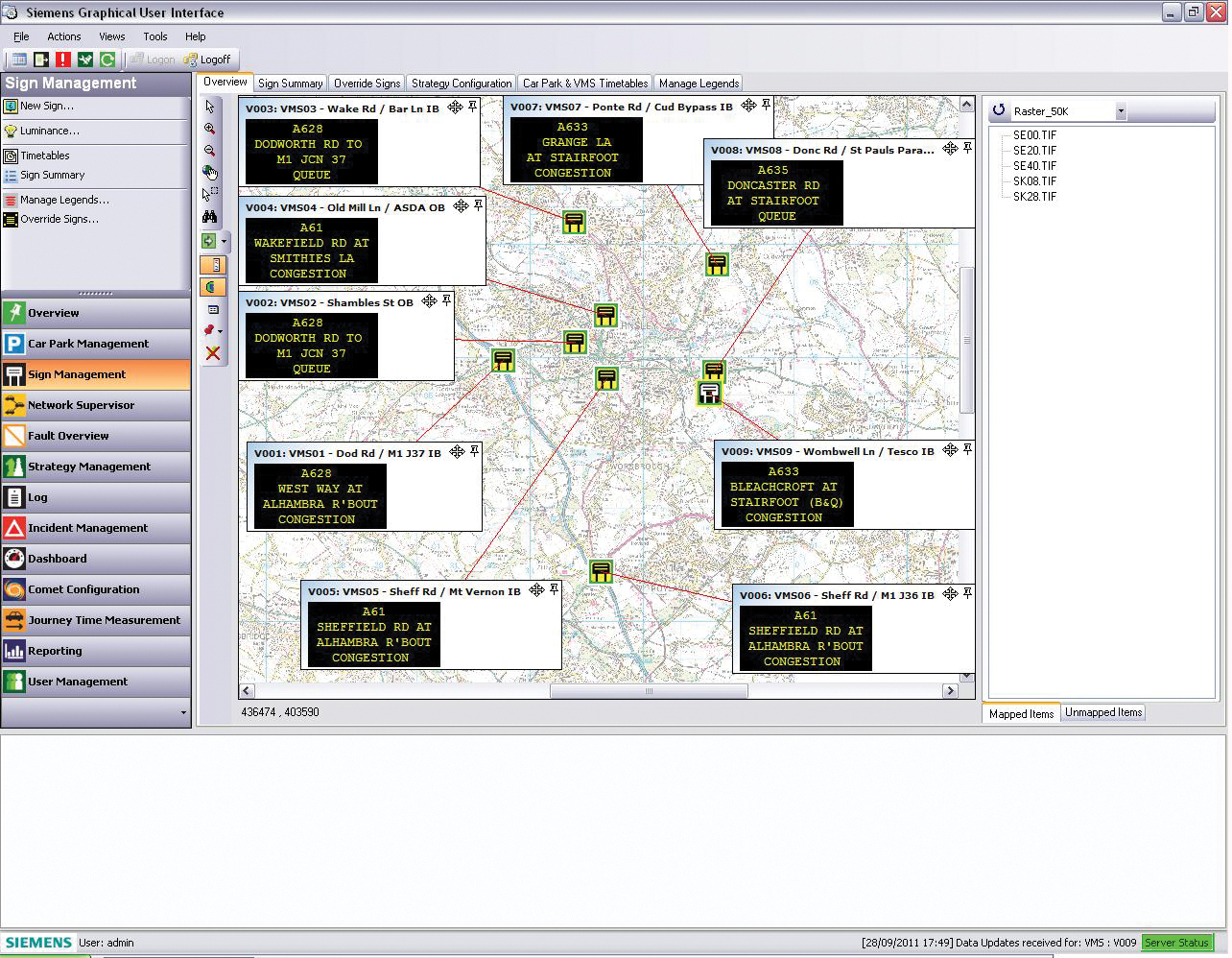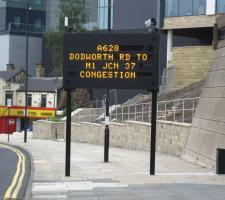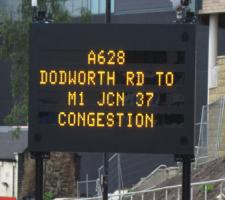
Barnsley’s system monitors traffic with thresholds for activation of automatic responses, so avoiding lack of integrity between what VMS units say and what drivers experience
Alterations to traffic signals and variable message signs are being activated to reduce congestion as soon as it occurs, through a pioneering fully automatic UTC system. Jon Masters reports
In the South Yorkshire town of Barnsley in England, strategies for dealing with traffic congestion have been devised from analysis of queue data, then made to work automatically: “This represents the future of ITS for urban traffic control,” saysCarr’s experience makes him a good authority on UTC developments in the UK, and further afield due to his connections within Siemens. To his knowledge, Barnsley can claim its automatic system to be a first for the UK and possibly worldwide. “I’ve received nothing to contradict that from colleagues,” he says. Also comparatively rare is Barnsley’s use of historical and current data stored in ASTRID (Automatic SCOOT Traffic Information Database) for devising strategic responses from systems of SCOOT detectors, traffic signal controllers and variable message signs (VMS).
“Such analysis of traffic queues opens up a lot of possibilities, allowing strategies for dealing with congestion to be worked out. Just as importantly, it allows trigger points to be identified. That could be two or three queues over five minutes and 15 minute periods, triggering the automatic response,” Carr says. “If queue data from multiple entries to a junction is used with other information such as traffic speed and congestion, then indication of node congestion can be gathered, allowing sign legends to apply to whole junctions. This is the next stage of analysis already under way in Barnsley.”
What Barnsley and Siemens have effected so far is an adaptive UTC system that works 24/7 without manual operation. SCOOT software controlling traffic signals has been configured to respond automatically when SCOOT loops record certain conditions of queuing at 34 junctions within the town. Around 140 different responses or strategies have been devised, in the form of variations to signal phase timings and legends displayed on new VMS units on arterial routes leading to the junctions.
It all sounds remarkably simple and sensible, which begs the question, why has it not been done before? “It is difficult to give an answer to that. I have worked in traffic control since the 1970s, experiencing all types of UTC system in the UK, but analysis of data and devising of strategies – the glue that makes it all work together – have often been overlooked. It is these elements, that which make systems ‘intelligent’, that are key to ITS systems,” says Carr.
“There are 102 SCOOT systems in use in the UK, but authorities have been reluctant to bring in automation. Perhaps authorities with traffic control centres and operators have not seen any need to make their systems automatic, but the whole idea of devising strategies is for making better use of resources. This project is showing what can be done.”
Motives behind Barnsley’s automatic UTC include a need to develop its ITS equipment to alleviate congestion and improve journey times, in a way that keeps long-term operational costs to a minimum. The council’s head of network management is Dave Pownall. He says: “It is possible to manually intervene in the system, but we wanted to avoid going down the route of having a staffed control centre, partly due to limitations on resources and long-term costs, but also because there are political issues surrounding use of VMS messages.
“Objections are often received from traders if messages are displayed that can be seen to discourage visitors,” Pownall explains.
“So there was a desire to have advice legends activated only when queues and congestion were actually occurring and we wanted this to be accurate and consistent. This system monitors traffic with thresholds for activation of automatic responses the same every time, so there is no problem of a lack of integrity between what the signs say and what drivers experience.”
For Barnsley’s automatic UTC, traffic loops of the SCOOT system have been configured as ‘call/cancel’ detectors for activating remote requests and counting the frequency of queues over five minute intervals. If these exceed predetermined thresholds, the system activates its two main functions of ‘queue relocation’ and display of appropriate VMS legends.
For reducing excessive queues, the UTC software automatically changes SCOOT validation parameters to adjust signal phase timing in favour of the congested route, in contrast to the equitable adjustments made by normal SCOOT operations. “Simple biasing for congestion is possible within SCOOT, but this has limited potential and cannot cope with extreme situations where excessive queues can lead to ‘exit blocking’ and gridlock if left unattended without a more radical intervention,” says Carr.
“The signal timings in Barnsley are changed above and beyond what SCOOT would normally do, instantaneous to detection of excessive queue build up. Normal SCOOT operations resume as soon as the queue reduces below the threshold; and all traffic flow, queue and congestion data is stored to demonstrate that the queue relocation strategies are working as intended.” Relocation is a deliberate term. Carr acknowledges that the automatic UTC reduces queues at the expense of traffic flow on interjoining routes temporarily. The council was not initially expecting its project to reduce the overall amount of traffic on its roads. The next stage is to publish information on the council’s website which will enable people to make informed decisions about their choice of mode. In the meantime, however, Barnsley has succeeded in reducing queues on key routes at peak times, according to its recorded data. More information is building for analysis, which is helping the next stages of the project. Barnsley has secured funding for installation of a further four VMS units. These will be installed in relation to more complex junctions in the town, interconnecting with the seven radial approaches already treated. Overall, the project represents a significant investment for the council. “The most important investment has been the relatively small cost spent on developing the strategies with Siemens,” Pownall says.
According to Carr, all operators of SCOOT systems already have all the software needed to do the same and more. SCOOT was designed by
Siemens’ next phase of work, already under way with Barnsley, is applying the same principles to more complicated junctions and wider regions including two signalled roundabouts vulnerable to congestion problems. “This is fairly easy to do once the parameters are known,” he says. “ASTRID provides very valuable data for analysing a junction’s performance. At Barnsley, it’s used as part of an annual audit of traffic flow, congestion, saturation and delay. It can then show junctions with the worst performance to justify investment and it’s a useful tool for devising strategies to deal with certain events. “Barnsley is close to the M1 motorway and so suffers from occasional M1 closures. ASTRID can be used to assess what happened as a result. There is a lot more sophisticated traffic control that can be done, all based on counting of queues over time.”













